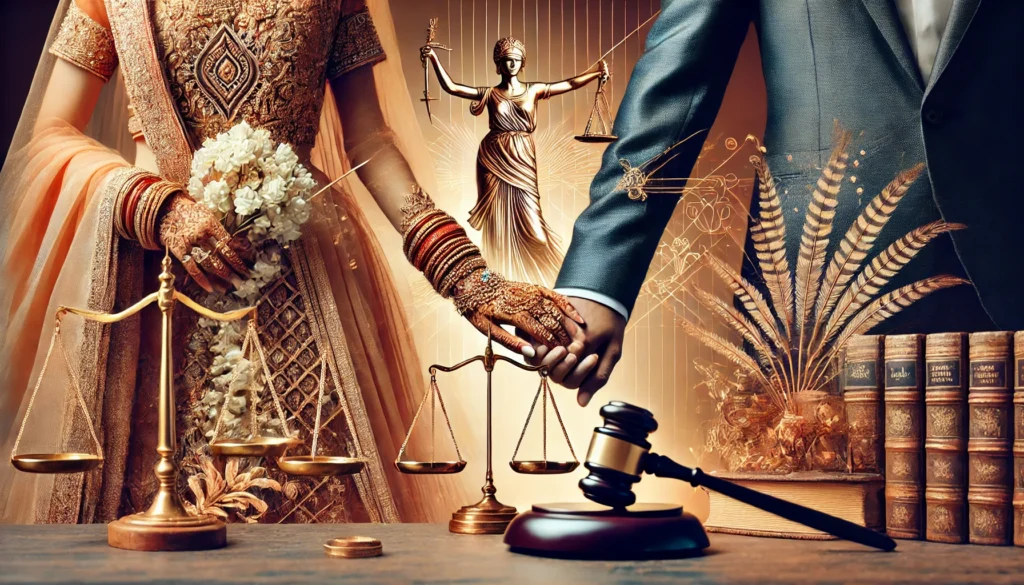Published on: 27th December 2024
Authored by: Parvika Rana
Symbiosis Law School, Noida
In India, marriage laws are the combination of the secular laws and personal laws regulating different communities while at the same time safeguarding that fundamental rights to marriage. The Special Marriage Act, 1954, is a civil law which regulates solemnizing interfaith marriages and marriages devoid of any religious semblance and applies to all the citizens. Along with this, personal laws related to marriage include the Hindu Marriage Act, 1955, Muslim Personal Law, Christian Marriage Act, 1872, and Parsi Marriage and Divorce Act, 1936, which regulate marriage in religious communities, having varying conditions about age, consent, ceremonies, and prohibited relationships that mirror India’s rich social and cultural texture.
Special Marriage Act, 1954
This is the all-encompassing marriage law which covered each and every citizen of India, for it provides for people of different religions or for those not intending to go through religious ceremonies a secular framework to solemnise marriage. The law is open to all Indian citizens irrespective of their religion, and therefore, it is regarded as an inclusive law stressing the concept of a civil and non-religious marriage. This can be considered to be the legislation most in consonance with other Indian Acts with its practical approach.
The requirements for a valid Special Marriage are:
- Preliminary Requirements[1]: Under the Special Marriage Act, the bridegroom should be at least 21 years old, and the bride should be at least 18 years old. If this condition is not met, the marriage so contracted will be void ab initio. Further acts such as Prohibition of Child Marriage Act further penalise any major person involved in such marriages.
Both parties should also be of sound mind and capable of consenting to the marriage. If one party is found to be unsound when the marriage was solemnised, or unfit for procreation or prone to frequent insanity attacks, the marriage is void.
Furthermore, the parties to marriage should not come within the ambit of “prohibited relationship” i.e. they should not be related by blood or by adoption in close proximity (one should not be other’s grandparent, parent, father/mother-in-law, uncle, aunt, sibling or cousin) as defined by the act[2].
- Monogamy: The Act requires that both parties be unmarried at the time of the marriage. That is, neither shall have a living spouse[3]. All marriages performed in violation of this rule are considered null and void.
A good example is the case of Radhika Sameena v. SHO Habeeb Nagar Police Station[4], where the couple, a Hindu female and a Muslim male, married under Special marriage act and the husband later contracted a second marriage. The husband had contended that he had married the second time under Muslim Personal Law, hence his marriage was Valid.
The court had held that since he had married under the SMA, his marriage will be viewed under the lens of that act and as such, he was prohibited from taking a second wife when his first wife had married him under a law which prohibited bigamy.
- Notice of Marriage: A specific requirement in this Act is that notice has to be formally given to the Marriage Officer 30 days before the date when the marriage is proposed to take months. It was held in Seema v. Ashwani Kumar that not obtaining the certificate invalidated the marriage[5]. If the marriage is not solemnised 3 months hereafter, the notice effectively expires.
Objections to Marriage: in the 30-day notice period objections can be made by any person with valid grounds (ex. Bigamy) following which Marriage Officer has to investigate and clear those issues before the marriage proceeds[6].
- Registration of Marriage: After its solemnisation, the marriage is registered under the Act and becomes a contract enforceable at law. Registration creates an official record of marriage, which also serves as proof of the said union in courts of law. This establishes rights regarding inheritance, maintenance, and property.
- No Ceremonial Requirements: As opposed to religious laws, there is no specific religious ceremony attached to the Special Marriage Act. It is solemnised by a procedure where the couple signs a declaration at the hands of the Marriage Officer and witnesses before three other people. This provision caters for couples belonging to different religions, or to no religion, or just desiring it to be a civil marriage[7].
The Hindu Marriage Act, 1955
This act is the foundational enactment addressing marriage among the four dharmic religions (Hindus, Buddhists, Jains, and Sikhs) in India. Section 2 of the Act states that the Act extends to any person who practices the Hindu religion in whatsoever form or follows Hindu customs.
While this is the personal law closest to the SMA in conditions for valid and void marriages, it still admits into its system the cultural and religious practices largely inbuilt within these communities, which see marriage as a sacrament.
- Requirements for Valid Marriage: The Act states certain conditions for a valid marriage, which are covered under the sections of 5 and 7. These have to be satisfied so as to make the union legally valid.
a) Capacity of the Parties
Under Section 5(iii) of the Act, it is provided that every bridegroom has to be at least 21 years of age and the bride must be at least 18 years of age, as is the case with SMA.
Further, Section 5(ii) also mandates that both parties must be capable of giving valid consent I.e. akin to SMA, they should not suffer from any mental illness or incapacity impeding their understanding of the nature and consequences of marriage.
Marriage voidable, not void: While the perpetrators responsible for marrying off the child are still liable for punishment under PCMA, 2006, it must be noted that the marriage itself is actually not void ab initio in HMA.
Similarly, marriage with a person of unsound mind is not void[8].
Instead, the decision to validate or avoid the marriage is given to the party minor during the marriage as soon as they are a major, or in a sound state of mind, as per Section 12.
b) Monogamy
Section 5(i) makes a marriage monogamous as it declares that at the time of such marriage, neither party to a marriage shall have a living husband or wife. Section 11 declares the bigamous second marriage void while Section 17 penalises the same.
A Hindu party cannot contract a second marriage until he/she is legally married to the first one was highlighted in Ramesh Daga[9] , where the second marriage of a woman not legally divorced from her first husband was found to be void, and her first one subsisting.
c) Prohibited Degrees of Relationship
Section 5(iv) holds that the parties should not be within the forbidden degrees of relationship unless the customs followed by at least one of the parties. Similar to SMA, HMA provides an index of forbidden degrees of relationship incorporating the same near blood ties, for example, siblings and close family members. Then there are Sapinda relationships, I.e. when two people share blood upto 3 generations from Maternal side or 5 generations from Paternal side, their marriage is not valid[10].
Furthermore, the Hindu law also strictly prohibits marriage within the same Gotra.
Once again, the marriage is not actually completely void. This decision to allow leeway, despite the general aversion from incestous relationships, was because there are certain Hindu subcultures, for example in Andhra Pradesh, which accept and recognise near-tie marriages. Although the marriage is prohibited for Hindus not from such cultures.
- Ceremonial Requirements: Section 7 provides for a marriage to be validly solemnised it must be performed according to the “customary rites and ceremonies” of either party. There is no particular “rite” or “ceremonies” which the parties have to follow because of extreme diversity in Hindu practices[11].
Yet, it does mandate for each subjective ritual to be precisely performed. For example, it was held in Priya Bala Ghosh that a marriage including Saptapadi will only constitute a valid marriage when the seventh step is taken around the fire[12].
Other practices, however, the Act does not reject; hence marriages carried out according to the varying regional rituals, such as either Phera the act of moving round or Kanyadaan the gifting away of the bride have also been recognized as legal and require performance.
- Void and Voidable Marriages: Sections 11 and 12 of the Act classify void and voidable marriages. By virtue of this classification, voidable marriages would include those that violate certain provisions on monogamy or prohibited degrees of relationship. Voidable marriages, however, are those where consent was not free, or when mental capacity is affected. This distinction allows the law to act on varying degrees of infraction in a marriage, making available specific remedies to parties under the facts.
Muslim Personal Law
Unlike other religions, whose personal laws are codified, the Muslim marriage laws in India exist primarily on the basis of Islamic religious texts, customs, and interpretations. Requirements for a valid Nikah are arranged in such a way that marriage is a contract, where considerations of mutual consent, financial responsibility, and social ethics come into practice.
- Proposal and Acceptance (Ijab and Qubul): In a valid Nikah, the surety of a clear and voluntary proposition from one side and its clear acceptance by the other must be present. The whole process, therefore, must take place in one sitting so that it is free from all obliquity and ambiguity. The offer as well as acceptance must also be clear and audible, and if there is any hesitation or conditionality, the contract is always vitiated[13].
The case of Rashida Khaatoon[14], where the plaintiff could not prove the event of such offer and acceptance, her marriage was held to be void because of lack of fulfillment of these terms.
According to Paras Diwan, this feature of marriage highlights the contractual character of Nikah in Islamic law, while distinguishing it from the sacramental nature of marriage in other religions.
- Capacity to Marry: The parties to the marriage must possess the legal and mental ability to enter into a marriage. Under Muslim law, there is:
a) Sound Mind: Both parties to the marriage contract must be of sound mind at the time of the marriage contract; they should be capable of understanding its nature and consequences.
b) Age of Puberty: In general, Islamic law holds that age of puberty is the age of majority to marry. There is no fixed age, but age is usually referred to as 15 years of age. However, in Indian law, courts are required to determine whether a person has attained maturity or not, irrespective of his or her chronological age[15].
This idea has been subject to conflict in the recent times, with a supreme court judgement on whether mid teens is a valid age for marriage despite it violating the legally enforced age of adulthood.
- Mehr (Dower): The Mehr or dower is compulsory payment that the groom would make to the bride for her safety and security with her hard-earned money[16]. It can be made on the day of marriage (prompt) or can be deferred to any later date, but it has to be clearly stipulated in the marriage contract[17]. This has nothing to do with bride price or dowry; rather, it is a legal duty that would protect her financially.
- Witnesses: A Muslim marriage has main three sects, and the need for witnesses varies according to each of these:
Sunni Law: Here, in this system of jurisprudence, it is essential that at least two male witnesses or one male and two female witnesses attend the Nikah ceremony. Witnessing the Nikah ceremony would act as a precaution to ensure that the marriage contract is publicized and open to both parties involved in a marriage.
Shia Law: The case of Shia jurisprudence does not entomb the involvement of witnesses in order to prove a valid marriage. This instead ends by depending on a trustworthy and well-informed Qazi or knowledge family member[18].
- Prohibited Degrees of Relationship: Muslim personal law strictly prohibits marriages within certain degrees of consanguinity and affinity based on injunctions from the Quran. such relationships encompass direct blood relations, siblings, in-laws who would be in prohibited relationship with one’s wife had she been a man and nursing relationships from foster mother’s side[19]. These marriages fall within prohibited degrees and have been held to be void (batil). Hence, In Sahih Jafr[20]i Case, where an uncle and a niece married each other, the marriage was held void.
Christian Marriage Act, 1872
Under the Christian Marriage Act, 1872, is the governing law for marriages conducted amongst Christians in India. The conditions and formalities under this act ensure that marriages get registered in a legally valid way but follow religious customs. Here’s what makes for a valid Indian Christian marriage in concise outline:
- Notice of Marriage: Under the Act, marriage seekers shall inform the concerned marriage registrar at least 14 days before the marriage ceremony is performed[21]. The whole notice period serves to allow for objections that may be raised in order to guarantee transparency in preventing fraudulent or coerced marriages.
- Age Requirements:The Act has prescribed that neither the bridegroom nor the bride should be below the age of 21 years. This law raises the age of marriage for Christain women and was challenged in the case of Mary Zoya Zachariah[22], but was held to be valid despite that. These ages go well with the general principle of Indian law relating to marriage and manifest maturity and preparedness of people entering into the lifelong bond.
Consent of Minor Party’s guardian: Unlike other personal laws, the Christian Marriage act allows marriage of a minor Christian, provided with consent if his guardian.
If either party to a marriage is less than 21 years of age, the consent of his or her guardian must accompany an application under this Act. Again, this is intended to protect the young, and their decisions to marry must be made with responsible guidance[23].
- Ceremonial Requirements: Christian marriages should be solemnized by either a license marriage registrar or a minister of the church. That can be through religious rites or a civil ceremony. This would thus leave it upon the couple’s personal preference to follow either religious rites or a civil ceremony. Furthermore, there should be two witnesses present at the ceremony of marriage[24].
After solemnizing the marriage, it should be registered with the marriage registrar. According to laws, it is to be registered in front of witnesses; after that this union will develop a legal record. Further, registration needs to be done for protecting the parties, and then both civil and religious authority should acknowledge the marriage[25].
Parsi Marriage and Divorce Act, 1936
The most central enactment governing marriage among Parsis in India is the Parsi Marriage and Divorce Act, 1936. The Act clearly lays down the requirements for a valid marriage, rendering it in consonance with the traditions of the Zoroastrian community and also supporting marital rights.
- Age Requirements: The Act makes the bridegroom at least 21 years and the bride at least 18 years of age[26]. Again, this is consistent with most other Indian personal laws, thus preventing child marriages and promoting healthy, maturely consenting unions.
- Monogamy: The Act allows monogamy marriage, which cannot be contracted if either party has a living spouse at the time of marriage[27]. That means marriage while any spouse is alive, or where the parties live together as husband and wife, is null and void-this is to say it does not have any validity in court. This reflects the values of the community in commitment and stability within the marriage.
- Ceremonial Requirements:The third, and as significant, feature of the Parsi weddings is that the rituals are legally framed to include solemnization by a Parsi priest (called Ashirvadam) in the presence of at least two Parsi witnesses. Within this context, it is ensured that the rituals are sacrosanct according to the cultural perspective because religious rites form the basis of the validity of marriage.
Forbidden Marriages: The Act completely prohibits marriages within certain degrees of consanguinity and affinity in the interest of avoiding any kind of union through close family relationships. The list is simar to those of Hindu and Special Marriage prohibitions[28].
References:
[1] Special Marriage Act, No. 43 of 1954, India Code (1954), §§ 4, 5..
[2] Special Marriage Act, No. 43 of 1954, India Code (1954), Appendix A.
[3] Special Marriage Act, No. 43 of 1954, India Code (1954), §§ 4, 24.
[4] Radhika Sameena v. SHO Habeeb Nagar Police Station, (2010) 5 S.C.C. 199 (India)..
[5] A.I.R. 2006 S.C. 1158
[6] Paras Diwan, Family Law (9th ed. 2020).
[7] Paras Diwan, Family Law (9th ed. 2020).
[8] Hindu Marriage Act, No. 25 of 1955, India Code (1955), § 12.
[9] (2005) 2 SCC 33
[10] Hindu Marriage Act, No. 25 of 1955, India Code (1955), § 5.
[11] Paras Diwan, Family Law (9th ed. 2020).
[12] Priya Bala Ghosh v. Suresh Chandra Ghosh, A.I.R. 1971 S.C. 1153
[13] Aqil Ahmad, Mohammedan Law 80 (25th ed. 2016)
[14] Rashida Khatoon v. S.K. Hasan Ali, A.I.R. 1962 Pat 107
[15] Aqil Ahmad, Mohammedan Law 102 (25th ed. 2016)
[16] Aqil Ahmad, Mohammedan Law 118 (25th ed. 2016)
[17] Nasra Begum v. Rizwan Ali, A.I.R. 2003 All 79
[18] Paras Diwan, Family Law 380 (9th ed. 2020).
[19] Aqil Ahmad, Mohammedan Law (25th ed. 2016)
[20] Sahih Jafri v. Sayed Abbas Ali, A.I.R. 1975 Bom 94
[21] Christian Marriage Act, No. 15 of 1872, India Code (1872), §§ 12, 38.
[22] Mary Sonia Zachariah v. Union of India, (1995) 1 KLT 644
[23] Paras Diwan, Family Law (9th ed. 2020).
[24] Id., §§ 5, 12, 27.
[25] Paras Diwan, Family Law (9th ed. 2020).
[26] Parsi Marriage and Divorce Act, No. 3 of 1936, India Code (1936), § 3.
[27] Id., § 4
[28] Paras Diwan, Family Law (9th ed. 2020).



